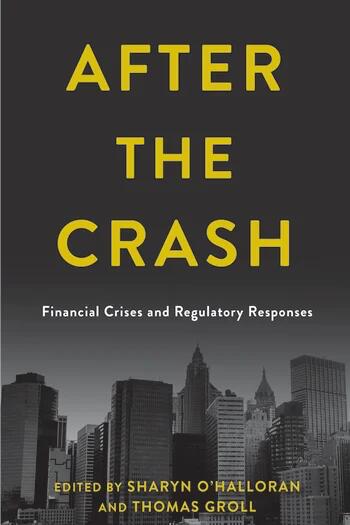
Risky Business

More than ten years after the global financial crisis of 2008, Sharyn O’Halloran, the George Blumenthal Professor of Political Economics and professor of international and public affairs, and Thomas Groll, a lecturer in the discipline of international and public affairs, have coedited After the Crash: Financial Crisis and Regulatory Responses (Columbia University Press), a collection of essays from economists, academics, and elected officials involved in regulation that provides a holistic reflection on the worst financial crisis and the most severe economic downturn since the Great Depression.
What was the impetus to create this book? When you started the process, what did you want to accomplish in assembling these various essays in one place?
O’Halloran: We were studying these issues ourselves, with a lot of data science techniques, natural language processing, and machine learning, both here and in Europe. And we were approaching 10 years [since the financial crisis] and kept thinking, “Have we learned anything? Have we actually grown in our understanding?”
Our own assessments were that the regulations, many of which were very good, still didn't hit the mark here or abroad. It wasn't clear to anyone whether the regulations that were being imposed were going to actually have the effect that they all hoped for, both in industry and in government.
And instead of just sharing our own work, we thought of bringing together figures from industry, from the government—from both Europe and other places in the United States—and top-notch academics to get a really good, 360-degree perspective of what was going on.
Groll: In 2017 people thought there was a political window for reform, so we wanted to take stock of what had happened over the [preceding] ten years—to review what we had learned, and see where there was room for potential discussion of improvements. I think what came out is that the system does seem to be safer; we stabilized the economy. At the same time nobody was really suggesting that we have efficient regulation in place. And the regulatory complexity is actually creating risk to some extent. The book also addresses the impact of new technologies like cryptocurrencies and cybersecurity.
We know that financial regulation usually comes after crashes. Hopefully we won’t require another crash to optimize our regulation. But the political windows when regulation actually can happen are limited; it's not free of politics, unfortunately
With an election coming next fall will there be possibly another political window for some regulation?
O’Halloran: What we're seeing now is that agencies are setting the rules using the discretion they have within big regulatory structures and statutes. So because there's been a lot of concern about liquidity crunches, for example, you're seeing some loosening up of things some capital reserve requirements. But more fundamental regulation, no.
The framework and thinking that comes out of this whole process is a notion of real risk identification and risk mitigation. I think what's novel about the book is that it illustrates how concerns about risk reshaped the way people want to think about financial regulation law. When does it happen, what are its impacts, and what do we look for moving forward? And I think that's what a lot of people grabbed on to. If there's a thread that runs through it, it's risk analytics.
You mentioned before that you were in touch with a variety of academics, both here and abroad, and other key figures like then congressman Barney Frank and former [SEC director and] JPMorgan vice chairman Stephen Cutler, among others. So how did you go about choosing the contributors?
O’Halloran: You build up a lot of community in this field. I talk to everybody; I have friends in a lot of places. In the end we got a very good group of people—at a very high level, across the political spectrum—who were very excited to take part.That was the way we went about it — finding the best and brightest in every segment and really reaching out. And we got a really good return rate on that.
How important is global coordination? Given the rise in nationalist idealism, dialogue, and rhetoric, does that play a role in how you regulate moving forward?
O’Halloran: The most important thing that immediately happened to stabilize the world economy [in 2008] were the swap markets opened by the central banks to make sure there was sufficient liquidity of movement of currencies [across the world], with enough dollars and Euros out there to make everything still move. And those swap markets were coordinated, completely untransparent, but had one primary objective—to assure liquidity. I don't see something like that as bumping up against nationalism, per se.
At the same time, to the extent that you need more coordinated efforts on regulation, on setting monetary policy, setting trade policy, that's where nationalism is going to really bite the real economy and, in essence, the financial system. Having central bankers being able to coordinate on having swaps available, that is a huge way to ensure stability within the global economy.
Groll: When you have a crisis moment, the risk is going to be spreading across the markets too much, so you want to have a coordination. And, obviously, the whole tariff and international trade component is going to be how nationalist real economy issues are going to go into a global, connected financial system.
This interview, conducted by Daniel E. White MPA ’20, has been condensed and edited for clarity.